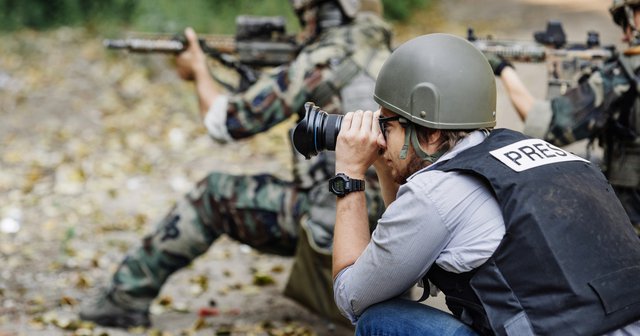

In today’s fast-paced world of social media, 24-hour news reporting, and information being shared at lightning speed, photojournalism plays a key role in the storytelling process. Whether it is capturing world leaders at international summits, highlighting issues such as war, famine, or climate change issues, or taking action shots of the leading sports stars, photojournalists capture moments that encapsulate emotion and reality.
In this post, we’ll look at what is photojournalism and the role it plays in the media. We’ll explore the impact it has on society, how significant it can be, and the role that a photojournalist has – either as a freelancer or within a large news organisation.
And if you are interested in career is a photojournalist, we’ll let you know what you should study – such as a Degree in Media Studies or a Master in Sports Journalism and Communications.
Photojournalism meaning
Photojournalism is a unique type of journalism that merges photography and journalism to capture significant moments and events. It's a powerful medium that allows us to witness stories, emotions, and issues from around the globe in a visually compelling way. Rather than relying solely on words, photojournalists use the lens of a camera to communicate and evoke emotions, making it a universal language understood by people of all cultures.
Role of a photojournalist
A photojournalist's job goes far beyond simply taking pictures. They are passionate storytellers, visual historians, and brave witnesses to events that shape our world. The role of a photjournalist will vary depending on where they work – some are freelance while others work for news outlets directly. Having said that, let’s look at some typical tasks a photojournalist does:
- Documenting Events: Photojournalists are at the forefront of major events, both celebratory and tragic. They strive to capture the essence and impact of these events, ensuring that the images communicate the story to the audience. From political rallies and protests to natural disasters and conflicts, they bear witness to pivotal moments in history.
- Telling Human Stories: One of the most powerful aspects of photojournalism is its ability to highlight the human experience. Photojournalists focus on capturing the emotions, struggles, and triumphs of individuals, giving a face to stories that might otherwise remain untold.
- Journalism Ethics and Accuracy: Photojournalists adhere to a strict code of ethics, ensuring the accuracy and authenticity of their work. They strive to present a truthful representation of events and avoid altering images in a way that could mislead or manipulate the audience. Maintaining integrity and respecting the privacy of their subjects are of utmost importance.
- Visual Storytelling: A photojournalist must possess exceptional storytelling skills. They meticulously compose each shot, considering light, composition, and perspective to create visually compelling narratives.
- Deadline-Driven and Adaptable: In the fast-paced world of news, photojournalists thrive under pressure. They must work swiftly to capture crucial moments and meet tight deadlines. These professionals possess the ability to adapt to various environments, from crowded urban settings to remote and challenging terrains, to cover stories effectively.
Future of photojournalism
Because the digital landscape is in constant change and evolution, the photojournalism sector has to adapt. Today, with the rise of citizen journalism and the advancements in artificial intelligence in particular, photojournalists face certain challenges as they look to the future. These challenges include:
- Citizen journalism and social media: The rise of citizen journalism and social media platforms has democratized the dissemination of news and images. While this provides an opportunity for diverse perspectives and real-time reporting, it also raises concerns about the accuracy, authenticity, and ethics of the information shared.
- Image manipulation and misinformation: Perhaps the biggest challenge at the moment is the availability of AI tools in the area of photojournalism and image production. Images can be created from scratch or altered, leading to concerns about the authenticity and credibility of photographs.
- Copyright infringement and compensation: Similar to the impact of AI on the photojournalism sector, the ease of digital sharing has resulted in widespread copyright infringement. Images can be used without proper attribution or compensation, impacting the livelihood of photojournalists. The need for robust copyright protection and fair compensation for their work remains a pressing challenge today and in the future.
What does a photojournalist study?
There are various ways to enter the photojournalism sector, and much will depend on what area you’d like to go into – news, sports, travel, for example. As well as having a passion for the camera, getting experience and building a portfolio is key. And at Universidad Europea, our academic model is based on a learning by doing approach. On the degree in journalism and international relations, you’ll have the opportunity to gain valuable work placements at prestigious media organisations. In addition, at our campus in Madrid, you’ll have access to outstanding media facilities including a photo editing lab.
Article published on May 25, 2023